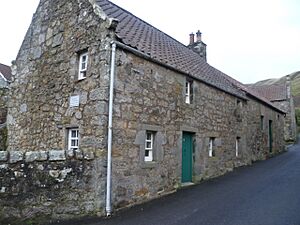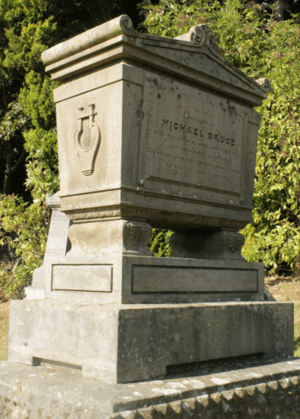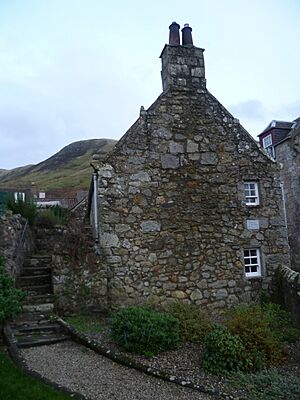Michael Bruce (poet) facts for kids
Quick facts for kids
Michael Bruce
|
|
|---|---|
| Born | 27 March 1746 Portmoak, Kinross-shire
|
| Died | 5 July 1767 (aged 21) |
| Nationality | Scottish |
| Occupation | poet, hymnist |
|
Notable work
|
Elegy written in Spring |
Michael Bruce was a Scottish poet and writer of hymns. He was born on March 27, 1746, and passed away on July 5, 1767.
Contents
Michael Bruce's Early Life
Michael Bruce was born in a small village called Kinnesswood, in Scotland. His father, Alexander Bruce, worked as a weaver. Michael learned to read very early, even before he was four years old. He loved reading books, and one of his favorites was by Sir David Lyndsay.
School was sometimes hard for Michael. He often had to stop going to school to help his family. In the summer, he would herd cattle on the Lomond Hills. Being close to nature at a young age greatly inspired his poems. Michael was a delicate child. His family and friends cared for him deeply.
He studied Latin and Greek in school. When he was fifteen, his schooling finished. A small amount of money left to his mother, plus help from kind neighbors, allowed him to go to college. He attended the University of Edinburgh for four winters, from 1762 to 1765.
Michael Bruce's Adult Years
In 1765, Michael taught school during the summer. He worked at Gairney Bridge. He earned a small amount of money and got free food from a student's family. He then became a student of religion. He studied at the Theological Hall in Kinross. This was part of a Scottish church group. People said Michael was truly religious. They believed his Christian faith was very real. His hymns and religious songs showed his strong beliefs.
In the summer of 1766, he took charge of a new school. This school was in Forestmill, near Clackmannan. Life there was difficult for him. He faced poverty, sickness, and loneliness. While there, he wrote a poem called "Lochleven." This poem was inspired by his childhood memories. It showed how much he was influenced by the poet Thomson. This poem helped him become known as a local poet. He was seen as one of the first to write Scottish songs.
Michael had already been sick with a lung disease. His health got much worse. During the winter, he walked back to his father's house. There, he wrote his last and best poem. It was called "Elegy written in Spring." Many people think it is one of the most beautiful poems in English. He died in 1767, but he stayed cheerful until the end. A poet named James Grant Wilson said in 1876 that Michael was "cut off in life's green spring." This means he died young.
The Logan Issue
Michael Bruce's fame as a poet grew after his early death. This was also because of a problem with another writer. It was believed that John Logan stole some of Michael's poems. Logan was a fellow student of Michael's. He got Michael's handwritten poems from Michael's father. This happened soon after Michael passed away. Michael's father did not keep a list of the poems. He also did not get a receipt for them.
In 1770, Logan published a book called Poems on Several Occasions, by Michael Bruce. The famous "Ode to the Cuckoo" was in this book. In the book's introduction, Logan said that some poems were by other writers. But in 1781, Logan published his own collection of poems. In this book, he printed "Ode to the Cuckoo" as his own. Michael's friends did not speak out publicly. However, a professor named Dr. Davidson said he saw a copy of the "Ode to the Cuckoo." It was in Michael's own handwriting and signed by him. Michael had written, "you think I might have been better employed than writing about a gowk (cuckoo)."
A friend of Michael's, David Pearson, wrote a book called Pious Memorials of Portmoak. In this book, he strongly stated that Michael wrote "Ode to the Cuckoo." This book was owned by the Birrell family. John Birrell, another friend of Michael, also agreed. Pearson and Birrell wrote to Dr Robert Anderson. Anderson was publishing his British Poets collection. They told him about Michael's claims. Anderson used their information in the "Life" section of Logan's works.
The 1770 book seemed incomplete to Michael's friends. His father also missed his son's "Gospel Sonnets." These are thought to be the hymns printed in Logan's 1781 book. Logan tried to stop Michael's poems from being reprinted. But the book was printed again in 1782, 1784, 1796, and 1807.
Dr. William McKelvie brought up Michael's claims again in 1837. He published Lochleven and Other Poems, by Michael Bruce. Logan said he wrote the poems because he published them under his name. Also, he was known as the author during his life. But Logan never showed the "poem book" Michael gave him. And no copy of "Ode to the Cuckoo" in Logan's handwriting was known to exist when Michael was alive. This makes it hard to clear Logan of stealing the poems. John Veitch wrote about this in 1887. He pointed out that a part of the ode, which Logan added, did not fit the rest of the poem. It was more like Logan's other poems. These poems did not have the simple style of the little poem about the cuckoo.
Michael Bruce's Poetry
Here are some of the poems Michael Bruce wrote:
- Elegy to Spring
- Elegy written in Spring
- Ode to a Fountain
- Ode to the Cuckoo
- A Pastoral
- A Pastoral Song
- Danish Ode
- The Works of the Eagle, Crow, and Shepherd
- An Epigram-Celia talking
- Inscription on a Bible
- The Fall of the Table
- Elegy to Spring-as a motto
- The Complaint of Nature
- Anacreontic to a Wasp
- Daphnis-A monody
- Fragments of Satires
- The Lovers (1760)
Michael Bruce's Hymns
Michael Bruce also wrote many hymns. Some of his hymns were chosen for important hymn books.
- Three of his hymns were printed in The Church Hymn book 1872. These were numbers 1064, 1356, and 1393.
- As Jesus died, and rose again was hymn number 1393 in The Church Hymn book 1872.
- Where high the heavenly temple stands was hymn number 1064 in The Church Hymn book 1872 (written in 1765). This hymn was even translated into Swedish by Erik Nyström.
- The hour of my departure's come was hymn number 1356 in The Church Hymn book 1872 (written in 1766).
- O happy is the man who hears is hymn number 446 in The Book of Praise [1].
- "Behold, the Mountain of the Lord" is Hymn number 54 in "Hymns of the Church of Jesus Christ of Latter-day Saints." (https://www.churchofjesuschrist.org/study/manual/hymns/title-page?lang=eng)
See also
- List of 18th-century British working-class writers
- Scottish literature




